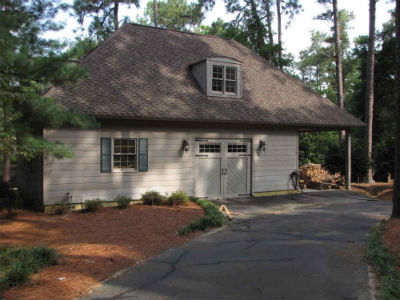
Here's My Workshop!
Roger Moore
Aiken, SC
Click on any picture to see a larger version.
I am a retired nuclear engineer currently designing and building custom furniture, cabinets, bookcases, yard furniture and structures, and what ever else comes down the "pipe." Also doing some antique repair work and making a host of family gifts.
Two of my shop storage ideas were included on the last page in this year's edition of America's Best Home Workshops. The shop was on last year's local Spring Home and Garden Tour as well as this year's Spring Garden Tour in Aiken.
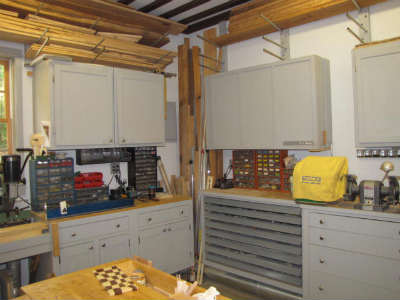
|
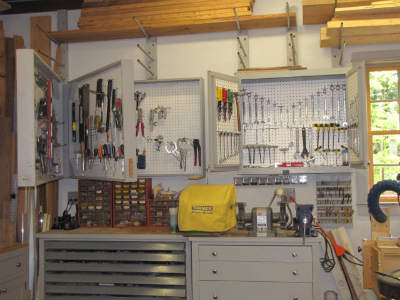
|
I started building this shop six months after I retired in 2003. It has two stories with the first floor measuring 28 ft x 50 ft and a second floor of approx. 600 sq.ft. The first floor is on a cement slab with 10 foot ceilings and 1,160 sq.ft. of shop space plus a 240 sq.ft. carport. I was able to put in a small bathroom on the first floor that incorporates a small shower, sink, toilet, and some cabinetry. The second floor is my wife's sewing/knitting studio, which is the main reason I could build such a shop. The two floors are separated by 16 inch I-joists and some beefed up laminated beams so I could include a 1/2 ton chain hoist just behind the carriage doors. The hoist was necessary so that I could unload heavy loads from a pickup truck which can be driven through the carriage door opening. All major equipment is installed on rolling platforms and casters.
The exterior of the shop is 10 inch wide custom milled red cedar siding that matches the siding on our house about 50 feet away from the shop. The roof has three skylights, three copper topped dormers and is shingled with Lifetime Tri-Laminate shingles made by Certainteed which also matches the roof of our house.
The two floors are separated by I-joists resting on 2×6 exterior walls. These design elements were necessary to eliminate all interior walls for more open floor space on the first floor. These features also allow R32 insulation for the walls and R55 insulation for the ceiling. The ceilings consist of brown painted I-joists with +5/8 inch sheetrock laid between the I-joists resulting in a ceiling that gives the appearance of a beamed ceiling. No screws, nails, tape or mud needed. Also, this arrangement gives total access to all of the ceiling for installing additional wiring, ducts, air lines, etc.
The shop is heated and cooled by a heat pump with a controller that allows separate thermostats in the upper and lower floors. For additional heat and emergency heat there is a wood stove installed in the lower floor which is used to supply most all of the heat during winter months. The two floors are separated by sliding bypass doors installed at the foot of the stairway which keeps most of the sawdust on the lower level.
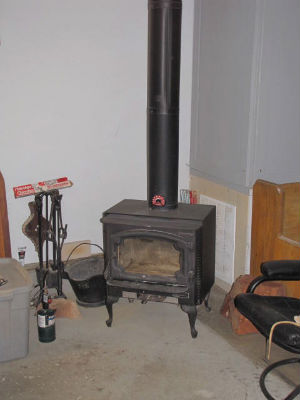
|
The building has three electrical panels. A 200 amp. panel in the lower level for the building, a 125 amp. panel for most of the major shop equipment, and a 125 amp. panel for the second floor. There are numerous 110V and 220V electrical receptacles in the walls and the ceiling of the shop and three 110V electrical reels installed in the ceiling of the main shop. This arrangement allows for a lot of power cables to be installed in the ceiling, up and out of the way. Lighting is predominately 8 foot fluorescent units using the new electronic ballast and T -8 bulbs which are proving to be efficient and reliable.
Air is supplied to the shop floor by a 60 gallon Ingersol Rand air compressor with a home made condenser and moisture collection/drain system. This system feeds three hose reels also installed on the ceiling up and out of the way. Condensed moisture is collected in a receptacle by the compressor that is periodically drained to the outside.
The dust collection system consists of an Oneida Super Gorilla Dust collection unit with self installed ducts, blast gates and flexible hoses. It and the air compressor are enclosed in a small separate room in the back corner of the shop with both an interior and an exterior door. This arrangement allows for collected sawdust and debris from the dust control unit to be easily removed from the shop. On moderate days the double door arrangement permits the interior door to be closed and the back door to be open so all air and fine dust from the dust control unit can be discharged to the exterior of the shop.
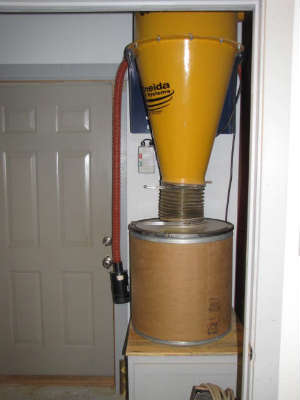
|
The lumber racks for stock storage are in the higher levels of the shop and consist of a simple arrangement of vertical 2×4's with 9/16 inch holes drilled in them at a 15 degree angle. This allows 18 inch long 1/2 inch electrical conduit to be installed in each hole resulting in a rack for holding wood up against the 2×4 base. This inexpensive design allows freshly milled lumber in the upper regions of the shop that are flat, warm and dry. Consequently, I am able to air dry most 4 quarter lumber to a workable level well within one year of cutting it. I was fortunate to have found a small one-man band mill a short distance from the shop that collects many of the logs from trees that are removed from the town in which I live. So far, I have been able to get poplar, hickory, maple, walnut, cherry, elm, sweet gum, heart pine, red oak, white oak, cedar, and sycamore and have them milled to my specifications and then air-dried in my shop.
I handle a lot of green, rough sawn lumber and use the carport and shop floor behind the carriage doors for initial unloading. The carport is equipped with an overhead ceiling fan to initiate the drying process, if necessary, before transferring to the shop interior.
A central circular work area is formed with the miter bench, which is equipped with a 12" Dewalt DW 715 compound miter saw and a 10" Festool KS 120 EB Kapex - Sliding compound miter saw. This bench also has a General 75-050T M1 tilting mortise machine. These three pieces of equipment are all on lockable sliding platforms allowing independent use of any piece of equipment on the miter bench. The miter bench has various T Trak fences and inserts to facilitate stops for repetitive cuts and is also equipped with retractable supports on the fronts of selected cabinets allowing stock up to 20 feet to be handled effectively.
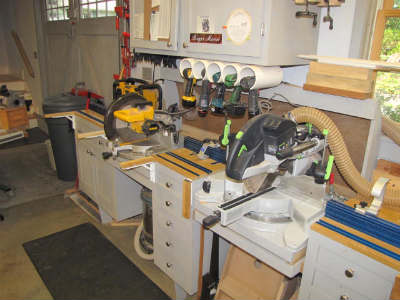
|
The table saw is a left tilt 10" Delta Unisaw equipped with a Biesmeyer Fence, a 52 inch support table and an out-feed table. A removable Leigh Dovetail Jig fixture is mounted on the far right side of the support table. A shop made assembly table was made at the same height as the table saw and support tables and was integrated between the out-feed table and the right support table. This table is fitted with Kregg Aluminum Klamp Traks, sliding Klamp Block stops and Bench Klamps and is used to efficiently assemble doors, face frames, and picture frames.
Casters are on all major pieces of equipment to facilitate changes in their placement as needed for various large projects and so vehicles can be brought into the shop for unloading and maintenance.
The jointer is a Delta 8" DJ-20, and the planer is a 15" Delta DC-380 equipped with a Wixley digital height gage. Both have standard straight blades that permits in-shop sharpening using a Tormek Super Grind sharpener.
The main sander is a 26" W1678 Shop Fox dual drum sander. Coarse grit (60-80) belts are usually used on the first drum which is useful in dimensioning and planing lumber, especially highly figured lumber. Finer grit (80-120) belts are generally used on the rear drum whose height can be independently adjusted from the front drum, allowing for finer sanding without changing belts. Smaller and finer sanding operations are accomplished by a Delta Boss spindle sander and a 6 x 48 Fisch combination sander.
The shop has two band saws; 17" General International 90-240-M1 and a Deluxe 14" Rikon 10-325. Both of these saws are fitted with Carter blade guides. Blades are maintained to use either saw for resawing but generally the 14" bandsaw is configured for finer work and the 17" bandsaw for resawing.
For drilling operations the shop has an old Rockwell-Delta radial drill press fitted with a shop made table that permits normal vertical drilling in horizontal positioned stock or drilling vertical mounted stock such as lamps, table legs, and pedestals.
For routing operations the shop is equipped with a shop made router table that is based on a design from Norm Abrams New Yankee Workshop. It is fitted with a Woodpecker router lifter and an Incra Fence system as well as a homemade fence. It also has sound proofing and an enhanced dust collection system.
If you would like to see some of Roger's woodworking projects,
CLICK HERE
.
You can also email Roger at
rogmr7@aol.com
.
Want to see more shops? Check out our
Shops Gallery
, featuring many of the
shops that we have featured in previous editions of Wood News.
Would you like for your shop to appear in this column? We invite you to
SEND US PHOTOS
of your woodworking shop along with captions and a brief history
and description of your woodworking. (Email photos at 800x600 resolution.) Receive a $50 store credit redeemable towards merchandise if we show your shop in a future issue.
